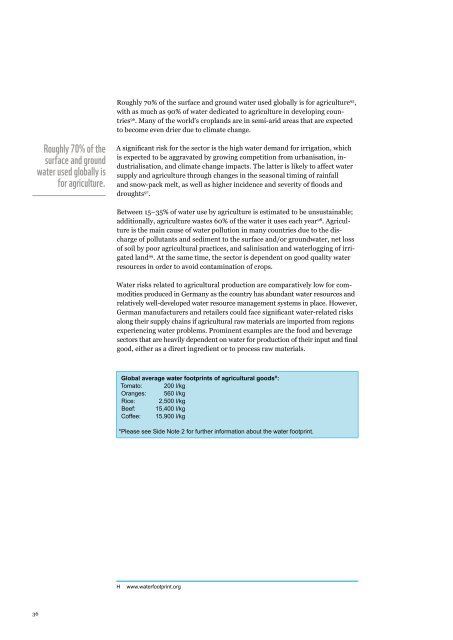YtDl2r
YtDl2r
YtDl2r
You also want an ePaper? Increase the reach of your titles
YUMPU automatically turns print PDFs into web optimized ePapers that Google loves.
Roughly 70% of the surface and ground water used globally is for agriculture 95 ,<br />
with as much as 90% of water dedicated to agriculture in developing countries<br />
96 . Many of the world’s croplands are in semi-arid areas that are expected<br />
to become even drier due to climate change.<br />
Roughly 70% of the<br />
surface and ground<br />
water used globally is<br />
for agriculture.<br />
A significant risk for the sector is the high water demand for irrigation, which<br />
is expected to be aggravated by growing competition from urbanisation, industrialisation,<br />
and climate change impacts. The latter is likely to affect water<br />
supply and agriculture through changes in the seasonal timing of rainfall<br />
and snow-pack melt, as well as higher incidence and severity of floods and<br />
droughts 97 .<br />
Between 15–35% of water use by agriculture is estimated to be unsustainable;<br />
additionally, agriculture wastes 60% of the water it uses each year 98 . Agriculture<br />
is the main cause of water pollution in many countries due to the discharge<br />
of pollutants and sediment to the surface and/or groundwater, net loss<br />
of soil by poor agricultural practices, and salinisation and waterlogging of irrigated<br />
land 99 . At the same time, the sector is dependent on good quality water<br />
resources in order to avoid contamination of crops.<br />
Water risks related to agricultural production are comparatively low for commodities<br />
produced in Germany as the country has abundant water resources and<br />
relatively well-developed water resource management systems in place. However,<br />
German manufacturers and retailers could face significant water-related risks<br />
along their supply chains if agricultural raw materials are imported from regions<br />
experiencing water problems. Prominent examples are the food and beverage<br />
sectors that are heavily dependent on water for production of their input and final<br />
good, either as a direct ingredient or to process raw materials.<br />
Global average water footprints of agricultural goods H :<br />
Tomato: 200 l/kg<br />
Oranges: 560 l/kg<br />
Rice: 2,500 l/kg<br />
Beef: 15,400 l/kg<br />
Coffee: 15,900 l/kg<br />
*Please see Side Note 2 for further information about the water footprint.<br />
H<br />
www.waterfootprint.org<br />
36


